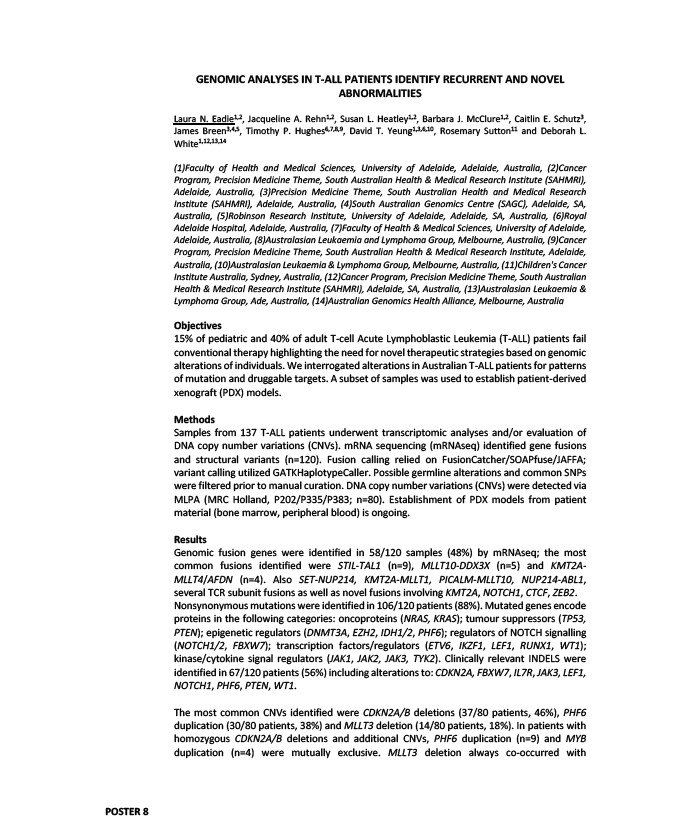
GENOMIC ANALYSES IN T-ALL PATIENTS IDENTIFY RECURRENT AND NOVEL
ABNORMALITIES
Laura N. Eadie1,2, Jacqueline A. Rehn1,2, Susan L. Heatley1,2, Barbara J. McClure1,2, Caitlin E. Schutz3,
James Breen3,4,5, Timothy P. Hughes6,7,8,9, David T. Yeung1,3,6,10, Rosemary Sutton11 and Deborah L.
White1,12,13,14
(1)Faculty of Health and Medical Sciences, University of Adelaide, Adelaide, Australia, (2)Cancer
Program, Precision Medicine Theme, South Australian Health & Medical Research Institute (SAHMRI),
Adelaide, Australia, (3)Precision Medicine Theme, South Australian Health and Medical Research
Institute (SAHMRI), Adelaide, Australia, (4)South Australian Genomics Centre (SAGC), Adelaide, SA,
Australia, (5)Robinson Research Institute, University of Adelaide, Adelaide, SA, Australia, (6)Royal
Adelaide Hospital, Adelaide, Australia, (7)Faculty of Health & Medical Sciences, University of Adelaide,
Adelaide, Australia, (8)Australasian Leukaemia and Lymphoma Group, Melbourne, Australia, (9)Cancer
Program, Precision Medicine Theme, South Australian Health & Medical Research Institute, Adelaide,
Australia, (10)Australasian Leukaemia & Lymphoma Group, Melbourne, Australia, (11)Children's Cancer
Institute Australia, Sydney, Australia, (12)Cancer Program, Precision Medicine Theme, South Australian
Health & Medical Research Institute (SAHMRI), Adelaide, SA, Australia, (13)Australasian Leukaemia &
Lymphoma Group, Ade, Australia, (14)Australian Genomics Health Alliance, Melbourne, Australia
Objectives
15% of pediatric and 40% of adult T-cell Acute Lymphoblastic Leukemia (T-ALL) patients fail
conventional therapy highlighting the need for novel therapeutic strategies based on genomic
alterations of individuals. We interrogated alterations in Australian T-ALL patients for patterns
of mutation and druggable targets. A subset of samples was used to establish patient-derived
xenograft (PDX) models.
Methods
Samples from 137 T-ALL patients underwent transcriptomic analyses and/or evaluation of
DNA copy number variations (CNVs). mRNA sequencing (mRNAseq) identified gene fusions
and structural variants (n=120). Fusion calling relied on FusionCatcher/SOAPfuse/JAFFA;
variant calling utilized GATKHaplotypeCaller. Possible germline alterations and common SNPs
were filtered prior to manual curation. DNA copy number variations (CNVs) were detected via
MLPA (MRC Holland, P202/P335/P383; n=80). Establishment of PDX models from patient
material (bone marrow, peripheral blood) is ongoing.
Results
Genomic fusion genes were identified in 58/120 samples (48%) by mRNAseq; the most
common fusions identified were STIL-TAL1 (n=9), MLLT10-DDX3X (n=5) and KMT2A-MLLT4/
AFDN (n=4). Also SET-NUP214, KMT2A-MLLT1, PICALM-MLLT10, NUP214-ABL1,
several TCR subunit fusions as well as novel fusions involving KMT2A, NOTCH1, CTCF, ZEB2.
Nonsynonymous mutations were identified in 106/120 patients (88%). Mutated genes encode
proteins in the following categories: oncoproteins (NRAS, KRAS); tumour suppressors (TP53,
PTEN); epigenetic regulators (DNMT3A, EZH2, IDH1/2, PHF6); regulators of NOTCH signalling
(NOTCH1/2, FBXW7); transcription factors/regulators (ETV6, IKZF1, LEF1, RUNX1, WT1);
kinase/cytokine signal regulators (JAK1, JAK2, JAK3, TYK2). Clinically relevant INDELS were
identified in 67/120 patients (56%) including alterations to: CDKN2A, FBXW7, IL7R, JAK3, LEF1,
NOTCH1, PHF6, PTEN, WT1.
The most common CNVs identified were CDKN2A/B deletions (37/80 patients, 46%), PHF6
duplication (30/80 patients, 38%) and MLLT3 deletion (14/80 patients, 18%). In patients with
homozygous CDKN2A/B deletions and additional CNVs, PHF6 duplication (n=9) and MYB
duplication (n=4) were mutually exclusive. MLLT3 deletion always co-occurred with
POSTER 8